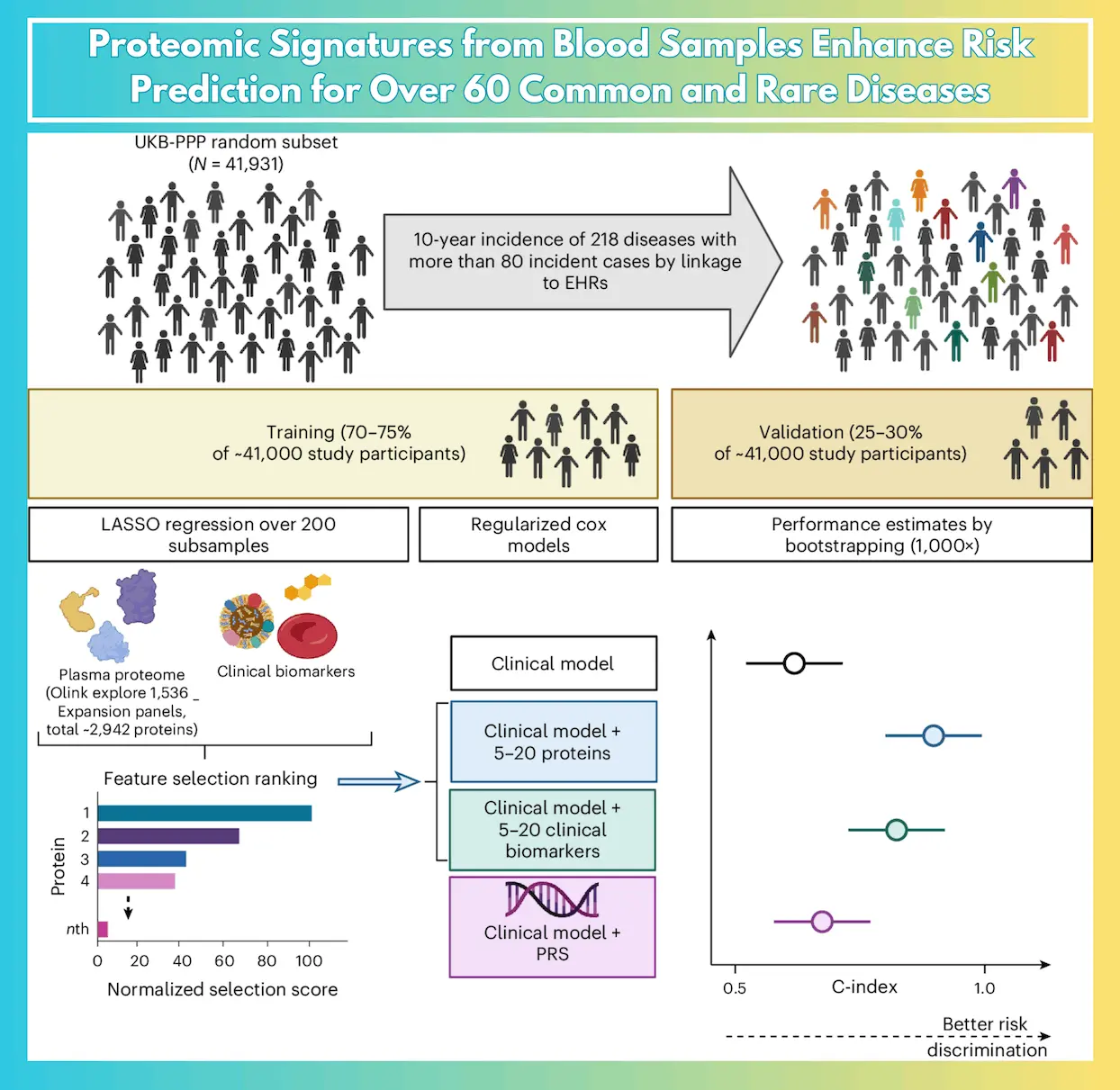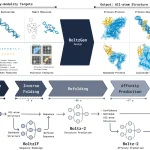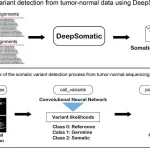Recently, Nature Medicine published a pioneering study that has found that protein signatures from blood samples can predict the appearance of over 60 common to rare diseases, enhancing early detection and prevention. The work was carried out by an amazing international team of scientists who have opened up new frontiers for early disease diagnosis, prevention, and personalized medicine.
Understanding Protein Signatures
Proteins are the basic building blocks of life, performing important roles within our body systems. They include functions like oxygen-carrying, tissue formation, and regulation of metabolism. Every protein has a unique form and function determined by its sequence of amino acids.
The phrase ‘protein signature’ means a specific protein pattern in biological samples such as blood or tissues. It is similar to a unique fingerprint that can tell whether health or disease prevails there. By studying these signatures, researchers may discover small changes suggestive of early-stage illnesses or even anticipate the likelihood of certain conditions in particular individuals.
Proteomics: A Powerful Force
Using proteomics approaches, scientists can analyze thousands of proteins simultaneously and thus get an all-encompassing view of the body’s internal environment. This technology has completely changed our understanding of disease, and it is now a powerful tool for designing new diagnostic tools and treatments.
One of the main advantages of proteomics lies in its ability to capture changes in dynamic protein levels. Proteins are constantly produced, modified, and destroyed compared to DNA, which is relatively still because it is affected by various issues such as diet, exercise, or environmental factors. Researchers can obtain important information by measuring these changes occurring with reference to treatment or disease progression. Besides, proteomics complements other omics technologies like genomics and metabolomics to give a more detailed account of human health and disorders.
A New Era of Disease Prediction
The findings of the study are truly remarkable; for 67 illnesses such as multiple myeloma, non-Hodgkin lymphoma, motor neuron disease, pulmonary fibrosis, and dilated cardiomyopathy, protein-based prediction models performed significantly better than conventional risk factors such as age, sex, BMI, and smoking status. These protein signatures could help identify individuals at high risk of developing these conditions years before symptoms arise, which would mean that they can be intervened early on and potentially even prevent or slow down their progression.
How Does It Work?
Determining the most important proteins for predicting diseases involves a lot of statistical modeling and biological knowledge. To identify the key proteins, scientists used advanced machine learning methods to analyze a huge range of data gathered from the UK BioBank.
Feature Selection: Finding the Needle in a Haystack
The first step involved identifying the most promising proteins from a pool of thousands. Feature selection is like finding a needle in a haystack. LASSO regression was employed by researchers as a statistical technique that automatically identifies important variables from large datasets. They were able to reduce the potential predictor proteins for each disease by applying protein data to Lasso regression.
Building and Optimizing Models
The next step was building statistical models to predict disease risk using some selected set of highly promising proteins. These models included both selected proteins plus traditional risk factors such as age, sex, or smoking status. The researchers then optimized these models using cross-validation, where data were randomly divided into training and testing sets several times. This mitigates overfitting, an issue commonly encountered in machine learning when the model becomes too closely tied to the training data and performs poorly on new data.
The Power of Sparsity
A surprising insight from the study was that a few proteins could yield considerable improvement in prediction accuracy. This is referred to as sparseness in extensive systems. It means that only a small fraction of proteins may be the main actors in diseases caused by protein signatures.
Some possible explanations for this sparseness include: Some proteins may actively participate in disease pathogenesis and serve as early indications of underlying biological processes. In addition, some of these proteins could be stand-ins for other more intricate biological mechanisms that are not easy to measure directly, such as inflammation-related proteins serving as a surrogate marker for multiple inflammatory pathways.
The Role of Machine Learning
This achievement of this study reflects how machine learning can revolutionize biomedical research. Modern algorithms can analyze large multidimensional datasets and identify hidden connections between variables that would remain concealed if traditional statistical methods were used. Many more exciting findings concerning the field of protein-based disease prediction will be anticipated with time due to increasing computing power and data availability.
The series of steps for recognizing disease prediction protein signatures include feature selection, model development, and optimization. Moving forward, it will be important to continue investing in research that can transform these findings into clinical practice. This would help shape future generations’ health. It means that personalized prevention strategies are implemented, thus making treatment interventions at an earlier stage convenient.
Looking Beyond Early Detection
Disease biology is another focus of this research. By knowing the proteins related to specific diseases, researchers can understand how diseases occur and identify possible treatment targets. For instance, higher levels of certain proteins connected with B-cell activity were strongly linked to an increased risk of multiple myeloma, which is a form of blood cancer. Findings like this could suggest new ways to prevent or cure this fatal ailment.
Conclusion
This study is a game changer in the area of disease prediction. Through proteomics, they have created an effective tool that can identify individuals who are at the highest risk of developing various diseases. Thus, this work could impact health care by enabling early interventions, personalized prevention strategies, and better outcomes for patients.
From here on out, it seems prudent to keep investing in research until we can put these findings into practice with sick people. This investment could help make us live longer than our ancestors did.
Join the Conversation!
What do you think about protein signatures’ potential to transform healthcare?
It’s a significant step forward when it comes to early detection of diseases and individualized medicine.
Please share your thoughts and comments below!
Article Source: Reference Paper | Reference Article | Associated code and scripts for the analysis can be found on GitHub.
Follow Us!
Learn More:
Anchal is a consulting scientific writing intern at CBIRT with a passion for bioinformatics and its miracles. She is pursuing an MTech in Bioinformatics from Delhi Technological University, Delhi. Through engaging prose, she invites readers to explore the captivating world of bioinformatics, showcasing its groundbreaking contributions to understanding the mysteries of life. Besides science, she enjoys reading and painting.










